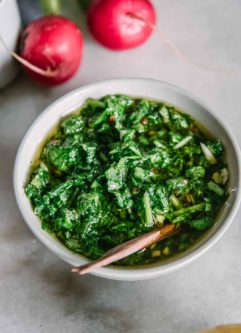Radish Greens Chimichurri
Radish Greens Chimichurri is a food waste recovery recipe using radish leaves instead of parsley in a traditional chimichurri recipe. Don’t toss those radish greens, use them in interesting ways to reduce food waste!
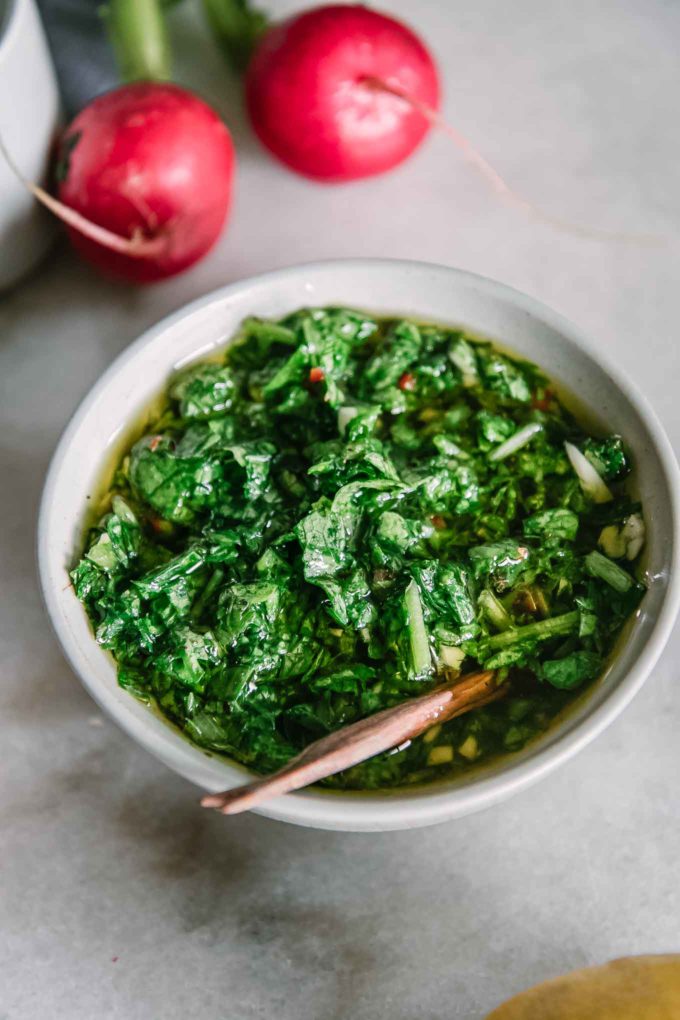
Want to Save This Recipe?
Enter your email & I’ll send it to your inbox. Plus, get new plant-based recipes in your inbox!
By submitting this form, you consent to receive emails from Fork in the Road.
Do you throw away radish tops? Most home cooks don’t give a second thought to radish leaves and throw them out without realizing they’re actually a deliciously edible green that’s tasty in sauces, salads, and soups.
Radish greens are a great replacement for herbs like parsley in traditional sauces like pesto and chimichurri. In fact, we’ve used radish greens in pesto and even sauteed them with garlic and red pepper as a delicious side dish. The radish greens possibilities are endless!
Here’s why you should be making chimichurri with radish greens:
- It decreases food waste. Put radish leaves to work in a zesty sauce like chimichurri instead of throwing them out.
- It’s crazy easy. Got 20 minutes? Then you’ll love this easy sauce recipe.
- It’s delicious! The most important reason to try this sauce is because it’s tasty, the earthy taste of radish greens gives chimichurri a subtle flavor punch.
Ready to learn how to reduce food waste AND make a delicious drizzling sauce? Let’s do it!
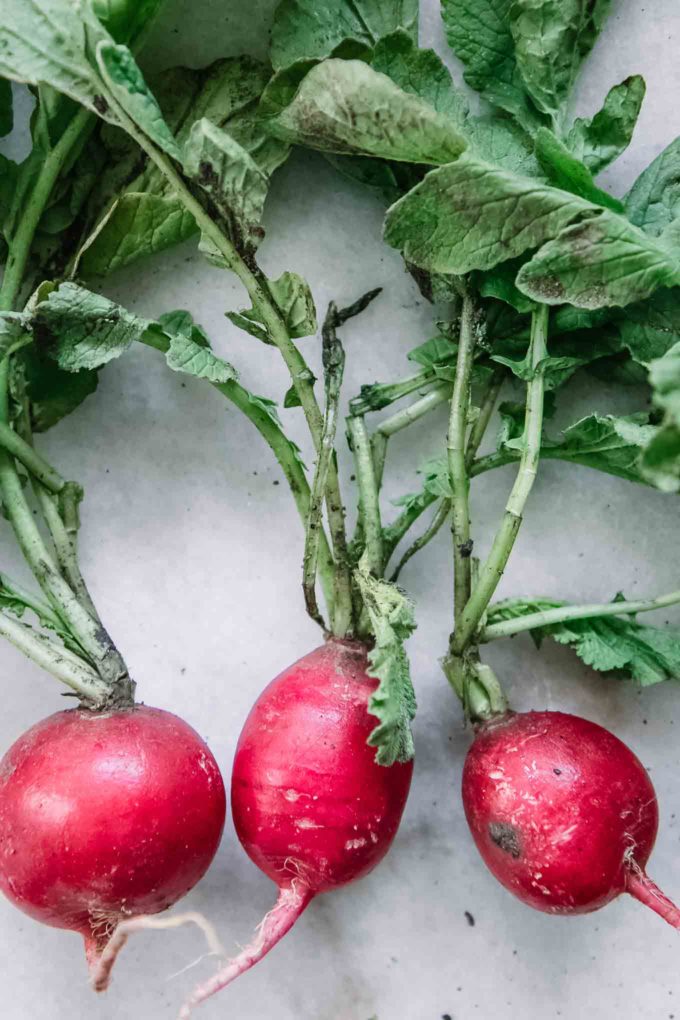
🌿 How to make chimichurri with radish greens (step-by-step)
1️⃣ Step one: Finely chop ingredients and mix together in a bowl
The first step to making radish greens chimichurri is to prepare the ingredients.
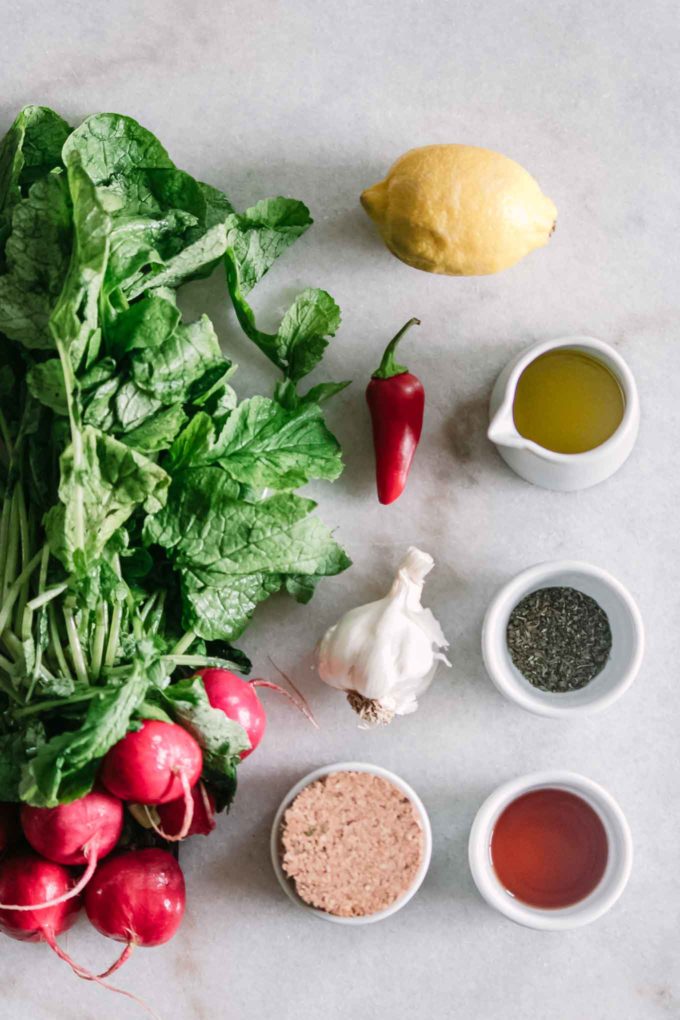
Chop the washed radish greens (see our full guide on washing radish leaves), garlic, and chilis until they’re very small. Because we’re not using a food processor or blender to make this chimichurri, we want to ensure all ingredient pieces are uniformly minced.
Next, add the chopped greens, garlic, and chilis to a medium mixing bowl and stir in the dried oregano, red wine vinegar, and olive oil. Stir to combine.
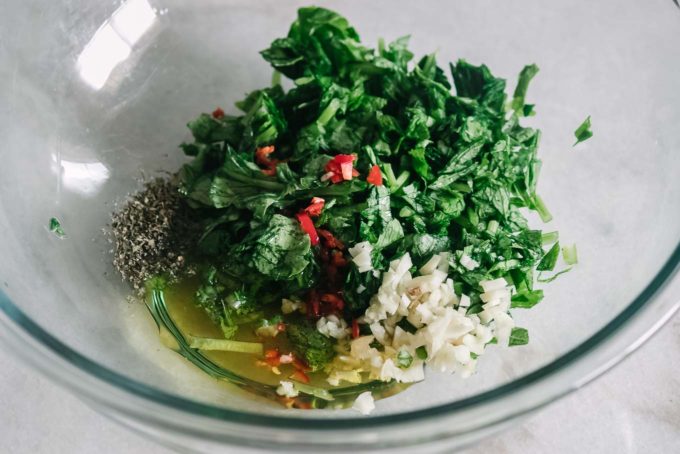
Why are we not using a food processor or blender for chimichurri? Traditional chimichurri is a looser consistency, with small bits of herb, garlic, and spices suspended in oil — not a thick herb sauce like you would get when blended. You can use a food processor to pulse the dry ingredients into small pieces and then remove and add to a bowl and mix with oil after to get the right consistency. However, we don’t want to blend the oil and ingredients into a thick sauce.
2️⃣ Step Two: Add salt and pepper to taste
Next it’s time to add the salt and pepper. Estimated amounts of salt (1 teaspoon) and black pepper (½ teaspoon) are provided in the recipe card below, but because each person’s salt sensitivity is different, we recommend adding them slowly and taste testing until you get the perfect amount.
The role of salt in this chimichurri recipe is to enhance the flavor of the herbs and spices, not overpower them. The taste of added salt will also get stronger as the sauce sits, so add a small amount and add more later if needed.

3️⃣ Step Three: Let sauce rest to enhance the flavor
The final step to making chimichurri is to do nothing — or rather, let the sauce sit so the ingredients combine and release their flavors.
We recommend a minimum of 10 minutes, but for best results try making the chimichurri 30 minutes before serving.
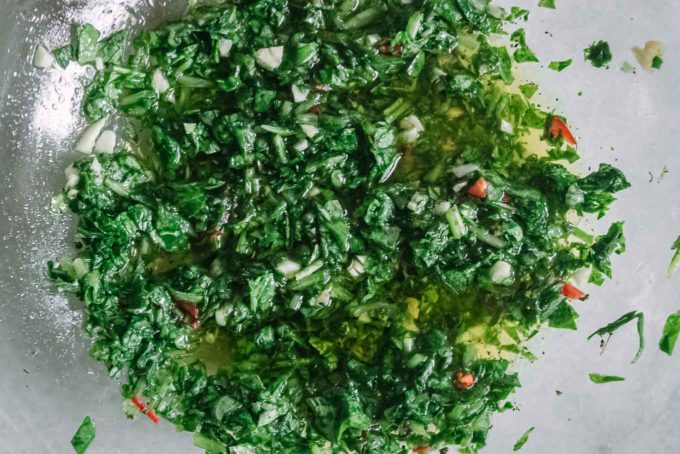
4️⃣ Step Four: Serve + enjoy!
Serve on top of roasted vegetables, plant-based burgers or sausages, mix into soups and stews, or as a dipping sauce for bread or raw veggies. Chimichurri can also be used as a marinade for vegetables that are roasted in the oven or grilled.
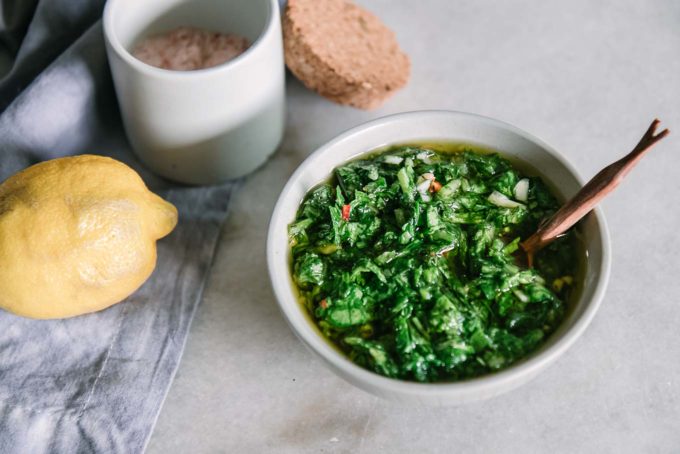
🥣 How to store chimichurri
If you’re making chimichurri ahead of time, or have leftovers after serving, follow these simple storage instructions:
- Store a room temperature for up to 4 hours: If you’re serving within 4 hours, the chimichurri sauce is fine to be covered and stored at room temperature.
- Store in the refrigerator for up to 3 days: If you’re serving the sauce later or have leftovers that will be eaten within three days, store in an airtight container in the refrigerator.
- Store in the freezer for up to one month: If you’re saving chimichurri to use for at a date later than three days ahead of time, freeze the chimichurri after it has had time to rest and release flavors. Store in an airtight container and freeze for up to one month. Thaw by setting sauce on the countertop for 1-2 hours. We do not recommend freezing again after thawing.
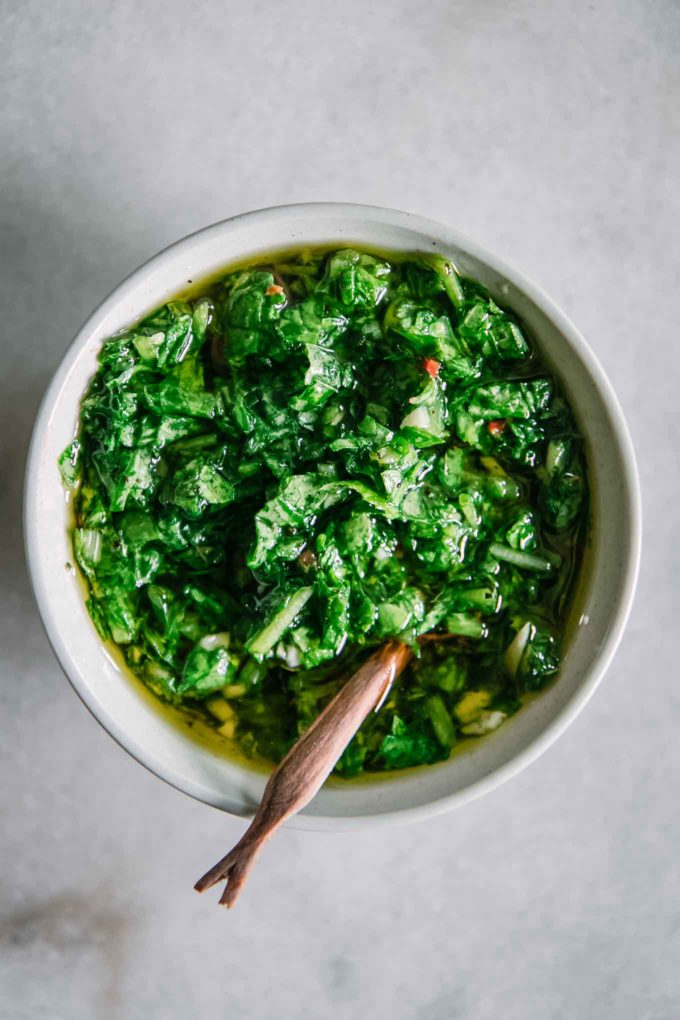
❓ Recipe + ingredient questions
Radish tops are edible, in fact they’re delicious! Radish tops are safe to eat and are not a poisonous vegetable. They do have a slightly bitter taste, so they are best paired with flavorful ingredients to cut the bite.
Radish tops are a sturdy and slightly bitter green that is perfect for mixed salads, as an alternative to parsley or cilantro in soups or stews, or sprinkled on top of food as a garnish. Radish leaves are also great in sauces like pesto or chimichurri.
Radish leaves are a nutritious leafy green that are high in vitamin K, vitamin A, and have about 90 calories per serving (about 1 cup of chopped greens) (USDA Food Nutrient Database).
Radish tops can be frozen for up to 2-3 months, possibly longer. It’s important to wash and completely dry the greens before wrapping a small cloth or kitchen towel and freezing in a freezer-friendly bag or container.
Traditional chimichurri sauces usually use fresh parsley and/or cilantro, but radish greens can replace one or both of these herbs for a hearty, earthy flavor.
♻️ Sustainable kitchen quick tips
While eating radish greens is sustainable in itself since you are using food that would otherwise be wasted, there are a few tips and tricks you can learn to make this chimichurri recipe even more environmentally friendly:
Take advantage of radish season! The best time to make recipes using radish greens is during the height of radish season. In California that’s actually year round, but check out Seasonal Food Guide’s produce seasonality calendar to find when radishes are in season near you.
Save radish stems for soup broths. While radish roots (the orange part we know and love) and radish leaves are edible, the stems of radishes are sometimes tough and bitter-tasting. We recommend cutting the hard stems a bit below the leaves and saving the stem scraps to use in things like homemade vegetable broth.

🌱 More recipes using radish greens
Radish leaves are great in sauces, soups, or even sauteed on their own! Check out our other plant-based recipes using radish greens:
- Radish Greens Pesto
- Radish Greens Pasta
- Simple Sautéed Radish Leaves
- Crunchy Radish Greens Chips
- No Waste Radish Tops Smoothie
- Radish Leaves Vegetable Soup
Looking for more recipes using radish roots in interesting ways? Try quick pickling radishes and thinly slicing and roasting radishes into chips.
Looking for more alternative chimichurri recipes? Check out our chimichurri with carrot leaves and chimichurri with beet greens.
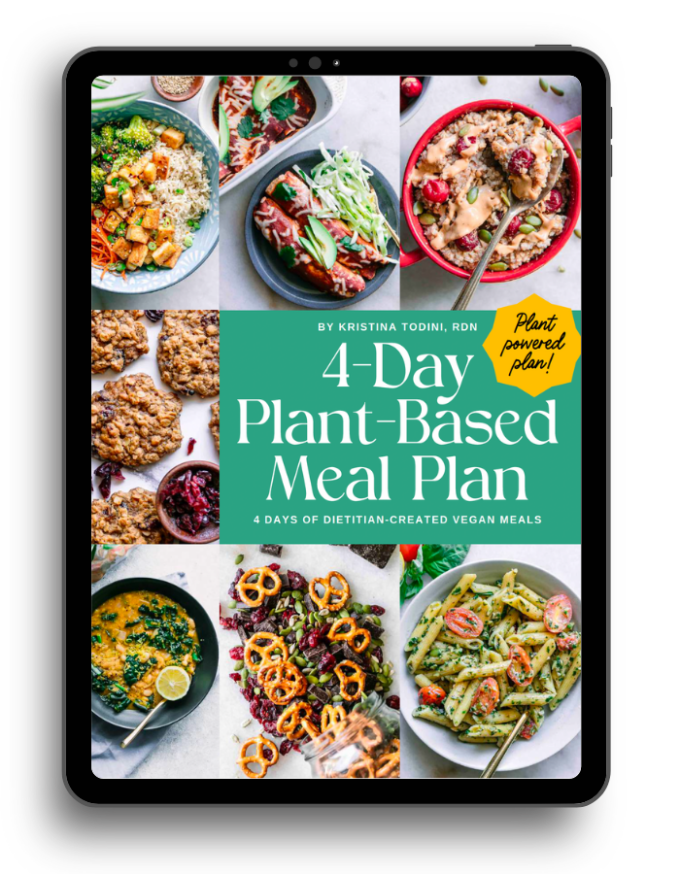
NOT SURE WHERE TO START WITH PLANT-BASED EATING?
Get my 4-Day Plant-Based Meal Plan to start your journey on the plant path.
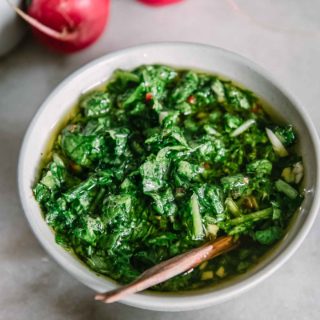
Radish Greens Chimichurri Recipe
Ingredients
- 1 cup radish greens washed and finely chopped
- 3-4 cloves garlic finely chopped
- 2 whole small red chilis deseeded and finely chopped (about 1 tablespoon)
- ¾ teaspoon dried oregano
- ½ cup olive oil
- 2 tablespoons red wine vinegar
- 1 teaspoon sea salt
- ½ teaspoon black pepper to taste
- Optional: cumin, paprika, or lemon juice to taste
Instructions
- Mix sauce ingredients: In a medium mixing bowl, combine the chopped radish greens, dried oregano, chopped garlic, chopped chilis, olive oil, and red wine vinegar. Slowly add the salt and pepper, stopping to taste test to ensure it’s not oversalted. Mix well to combine all ingredients.
- Let the sauce sit to enhance flavor: Let the chimichurri rest for a minimum of 10 minutes before serving, but for best results make the radish greens chimichurri 30 minutes ahead of serving so the flavors have time to reach their full potential.
- How to serve: Serve on top of roasted vegetables, plant-based burgers or sausages, mix into soups and stews, or as a dipping sauce for bread or raw veggies. Chimichurri can also be used as a marinade for vegetables.
Notes
- Recipe notes: We highly recommend taking the time to finely chop all ingredients and mix together in oil rather than making the chimichurri in a food processor or blender. Traditional chimichurri is a looser consistency, with small bits of herb, garlic, and spices suspended in oil — not a thick herb sauce like you would get when blended. If you are using a blender, simply pulse the dry ingredients and then add to oil after to get the right consistency.
- Tools needed: kitchen knife set, glass mixing bowls
Prep Ahead and Storage: Make the chimichurri up to 3 days ahead of time and store in the refrigerator until ready to serve. Remove from the cold refrigerator at least 30 minutes before serving to bring to room temperature. You can freeze chimichurri for up to one month, possibly more. - Nutrition notes: Chimichurri nutrition information is estimated without optional ingredients.

